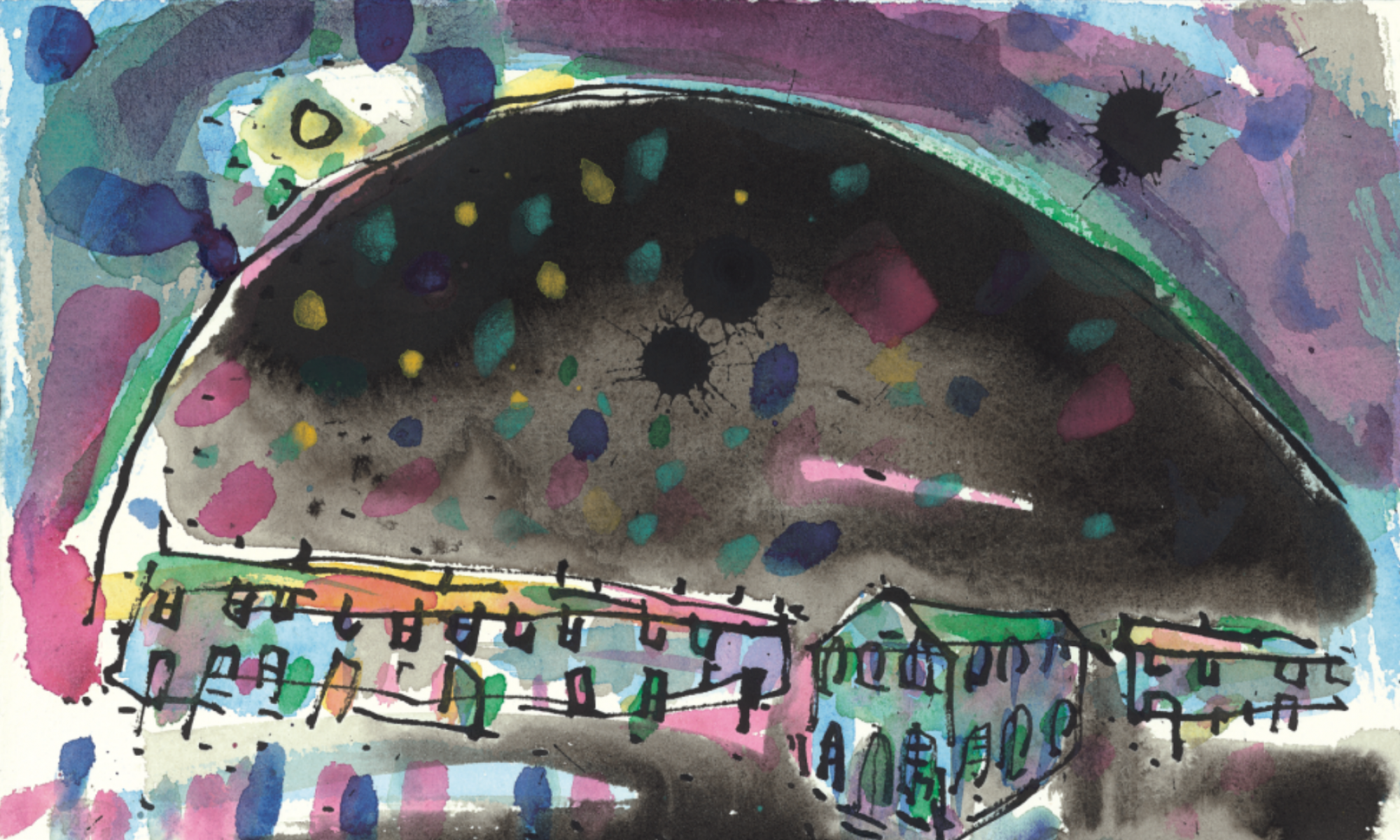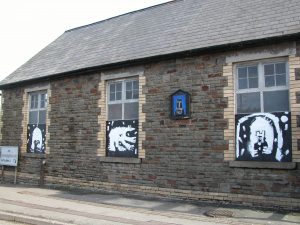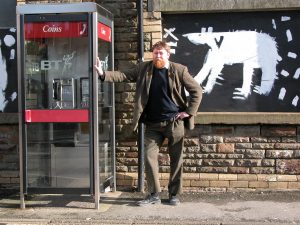Contributions from Keith Bayliss
Contributions from Keith Bayliss
The Green Monkey on the Street of the Czech and Slovak Army
Malcolm Parr and I arrived first. William was to follow a day later. The Czech poet Josef Janda had arranged an exhibition for me and William and Malcolm’s poetry at the little gallery at Vysehrad above Libuse’s bath, high above the Valtava, Prague. Accommodation was found at the apartment of a magazine editor on the street of the Czech and Slovak army. Pavel spoke a few words of English, his wife spoke none. Our first day was interesting, but strained with little conversation and a feeling that Mrs Pavel was not very pleased with the obvious inconvenience that we caused her and her family. The evening was spent at the Raven, a Prague pub with a group of Czech Surrealists. We learned a lesson that evening, never tell a joke to a group of Surrealists, they take it so seriously, but alcohol helped ease the evening along.
William arrived the next evening and strangely the atmosphere changed. William seemed somehow magically to be able to communicate regardless of language. Pavel instantly understood what William said! Not only that but Malcolm and I seemed also to be able to make ourselves understood.
Next morning, while we waited for our transport to the gallery, William decided to improve the situation regarding Pavel’s wife. The apartment was quiet, all were out. William noticed a sink full of the family’s breakfast dishes, “come on” he said with a wink, “we will change the atmosphere”. We washed the family china, placed all neatly away. That evening after hanging the show and an evening at Pavel’s local we arrived home to a smiling wife and the most wonderful unexpected supper. William had magically altered the situation. Did he work on instinct? He was a great observer of people. Maybe that was the answer.
The Prague trip was a magical adventure; we searched the dark corners of Prague looking for the Golem, exchanged artwork with a woman who appeared out of the blue wanting to meet “the Celts” and give us gifts and then disappeared, talked for hours with Pavel about the youth drug problem in Prague, publishing and holidays in Russia with no common language! And what of the Green Monkey? Malcolm saw that in the middle of the night, floating across his bedroom. When relating this the next day, Pavel apologised. “Yes, sorry, we have a spirit, it is a green monkey”. This gave birth to the appearance of the Bubak , a worrying sprite or spirit, in Williams paintings. On reflection, what more would you expect from a journey to Prague with William.
Keith Bayliss – statement for St David’s Hall
William Brown (1953-2008)
William was a Scots Canadian, who carried with him a restless search for “home”. From Canada to the West Country, William travelled, made friends and art. Here he met and married Carys. Then to Carys’ Wales, where they
made a home together. Williams work is an amalgam, a brilliantly coloured fusion of Canada, with its wolves and bears and Wales with its hills, chapels and villages. He was constantly adding to his visual dictionary, images from Canada, Wales and North Africa (North Africa held a fascination for him), creating a new world in which we could live. The mysterious and reclusive animals of the cold North, wander through a landscape of pine and palm tree or hide beneath the kipper laden dinner table, together with the Buback, that troublesome little Czech monster William, Malcolm Parr and I met in Prague one dark night. The Lou Garou, terrifying wolf spirit of the Canadian forest, Mari Llwyd and the Venus of Blaengwynfi (discovered by William in the dark recess of his imagination) dance a crazy dance together all in the one image. Each had a meaning for him, each was important to him. All were to him real.
William made contact with people and in doing so brought people into contact, creative contact, with each other. He was a catalyst, an engine, a dynamo in disguise. He could not understand the invisible territorial boundaries we impose on ourselves in Wales, like his friend the poster artist Paul Peter Piech, Williams enthusiasm in bringing together sometimes a hybrid mixture of artists under the banner of an exhibition, proved a creative act in itself. William made things happen and by doing so encouraged others to make things happen. Art was his work and every morning William went to work, art was his occupation, “These” he would say, “are what I have, the tools of my trade”, holding out the palms of his hands.
Keith Bayliss
Just William 1953-2008
It was around nineteen years ago that William Brown came into Wales, the office I occupied and my life. I knew then that something significant had happened and that my life and the arts in Wales would never be the same again.
At that time – it seems another life ago – I was the Community Arts Officer based at the Glynn Vivian Art Gallery, Swansea. William had sent one of his letters, a William Brown letter. William Brown letters were to become a colourful, sometimes confusing and mystifying aspect of his friendship with many artists, educators and administrators in Wales. On the strength of the letter a meeting was arranged. Within a few weeks I had organised William into a community residency in a small village in the Swansea Valley. I had housed him in a small chapel school house. Within a day or two William was being fed Welsh cakes and tea by the little old lady next door and seemed to know most of the main characters from the community. Within weeks, as if by magic, William had repeated the same trick on a national scale, seeming to have made contact with many of the creative people in Wales. I saw this marvellous facility, to make friends almost instantly, demonstrated some years afterwards in Prague. We spent a week in the flat of a magazine publisher with no common language but conversed every evening for hours! How was this magic trick achieved? It was the presence of William Brown.
William made contact with people and in doing so brought people into contact, creative contact, with each other. He was a catalyst, an engine, a dynamo in disguise. He could not understand the invisible territorial boundaries we impose on ourselves in Wales, like his friend the poster artist Paul Peter Piech, Williams’s enthusiasm in bringing together sometimes a hybrid mixture of artists under the banner of an exhibition, proved a creative act in itself. William made things happen and by doing so encouraged others to make things happen. Art was his work and every morning William went to work, art was his occupation, “These” he would say, “are what I have, the tools of my trade”, holding out the palms of his hands.
William was a Scots Canadian, who carried with him a restless search for “home”. From Canada to the West Country, William travelled, made friends and art. Here he met and married Carys. Then to Carys’ Wales, where they made a home together. Williams work is an amalgam, a brilliantly coloured fusion of Canada, with its wolves and bears and Wales with its hills, chapels and villages. He was constantly adding to his visual dictionary, images from Canada, Wales and North Africa (North Africa held a fascination for him), creating a new world in which we could live. The mysterious and reclusive animals of the cold North, wander through a landscape of pine and palm tree or hide beneath the kipper laden dinner table, together with the Buback, that troublesome little Czech monster William, Malcolm Parr and I met in Prague one dark night. The Lou Garou, terrifying wolf spirit of the Canadian forest, Mari Llwyd and the Venus of Blaengwynfi (discovered by William in the dark recess of his imagination) dance a crazy dance together all in the one image. Each had a meaning for him, each was important to him. All were to him real.
The more I find out about William, the less I know. William would say that is how it should be.
Keith Bayliss, January 2009
Letter from Dorothy and Johannes Glaw
Letter from Dorothy and Johannes Glaw
Gütersloh, Germany, 5th October, 2013
Dear William,
We feel a strong desire to write these lines for you, Carys and all those, like us who loved you and remember you dearly.
Not a week goes by here in Gütersloh (Westfalia) when we do not have a look at your pictures and think about you. Not only we two, Johannes and Dorothee share mutual meetings and talks, but also many inhabitants of Gütersloh have you in their memories since you have often been to this city. Due to this fact, as well as through your open-hearted manner, you have got to know a lot of people. Many art enthusiasts have been able to admire (and in some cases buy) your works; pupils of the Evangelisches Stiftisches Grammar School have experienced you and through your particularly instructive manner have learnt the techniques of wood block cutting for prints. You quickly managed to get into contact with artists from Gütersloh, and within the framework of “Symposium Young Arts” you had been able to have varied meetings with young artists from different countries, for example from Russia, Poland, the Czech Republic, France, the Netherlands as well as Peru. During these art events, you not only worked together but you also lived, discussed a lot, and now and then celebrated together with us. Through this, you came closer to each other, in some cases friendships were formed, but it was through your open-minded manner in the way you approached people who had a considerable influence on the group in question. In connection with this, you always had an open ear for the artists from East European countries when they described the problems of everyday life there and you conducted serious discussions while having a glass of beer (sometimes more than one). Apart from this, you managed to demonstrate to the young artists using your inimitable technique how to complete a wood cutting, how to experiment within this medium and even to work together with them on a block of wood. All of them shared this with you, despite or perhaps because of your professionalism and because you always remained yourself. You never pushed yourself into the limelight, although your pictures in their archaic interpretation have always been at the forefront! This is what the artists who had met you esteemed highly but also those from Gütersloh who got to know you. You were more than just an artist, you were William, our friend.
When we both (Johannes and Dorothee) browse through our guest book in which many other artists from all over the world and over the past 20 years have written something, then we are particularly attentive to those pages which you have written, drawn or painted. But the question is: Where did we really get to know each other?
2.
It was at the end of the 1980s when Johannes and William first met during a project organised by Johannes within the framework of an internationally relevant branch of art known as Mail Art. In this case, William participated in the project with a contribution called “Bookmarks” involving potato prints.
After this, the two of them developed a stream of correspondence and impressed by William’s works, Johannes invited William to exhibit his art in Gütersloh in 1990. As a result, William came to Gütersloh for the first time and the two men got to know each other, creating empathy on both sides. And so during the time when William lived in Johannes’ home, while drinking a pint of beer or a cider, they were able to discuss splendidly topics such as history, philosophy and myths, art, put in a nutshell, the important things in life. Out of this first meeting, due to a shared feeling of mutual kinship, an intensive contact developed which turned into a genuine friendship later.
During one of William’s stays in Gütersloh there was a humorous incident. One evening there was a ring at the doorbell. Johannes opened the door and to his great surprise two policemen carrying machine-guns stood at the door. Apart from this, the whole house was surrounded with police cars. Frightening! The police questioned Johannes about his “strange” guest and asked for William’s personal documents. What was the reason? During that afternoon, William had gone for a walk through the living quarters of the Royal Air Force which is adjacent to Johannes’ house and during this walk had made drawings and sketches. This fact drew the attention of the inhabitants living nearby who then informed the police. They thought that perhaps he was a member of the IRA. This assumption was influenced by his appearance as well as the fact that the IRA had conducted several attacks on the British Forces during that time. In a fully relaxed manner, William showed the police his Canadian pass and after apologizing, the police swiftly left.
In the summer of 1993, Johannes and Dorothee travelled to Bridgend for the first time to see William and Carys. On the first evening during our completely hearty meeting, William served us a duck soup and revealed his passion for cooking. Again and again William was interested in recipes from Germany, especially those involving dumplings from the South of Germany. The question is if he ever prepared these dumplings in Wales.
Already again in January 1993, Johannes went to Bridgend for a few days, in this case in connection with an exhibition. Then in June, William and Carys came to Gütersloh for a few days. During this time, there was an event involving a meal of fish in a restaurant in Bielefeld called “Kleine Plötze” (“The Little Roach”) where prawns were served in generous quantities. William, Carys and Gilbert Bender (a friend and artist from Bielefeld) enjoyed this pleasure to the full. Unfortunately, Johannes (who does not like prawns) was unable to feel the same degree of enthusiasm. Inspired by the prawns, William was able to do a drawing for our guest book.
Only a few weeks later in September, William came to Gütersloh again, this time as a participant in the “Third Symposium Young Arts” which had been arranged internationally for the first time. William was not only the heart and soul of the group of artists, but also he was bound through a strong relationship to Maxim Issaev from Russia. The way both of them sat down with a glass of whisky in a melancholic atmosphere and began philosophising and where Maxim said “…is really good but not Vodka” remains unforgettable. Of course, William stayed with Johannes and Dorothee, the other artists lived with other families with whom the two are on friendly terms. And so William became “Fifi- the au pair (bear)”and among other things even cooked for the other artists in the group. William was very creative with the house work so that even the most boring jobs became events; facts which he recorded in our “Meetings” book in a humorous manner.
Once again, William was a participant in the “Symposium of Young Arts” in Gütersloh, and in this case in March 2000. And once again William was the heart and soul of the group who infected the art group with his brilliance and enthusiasm. And when the long day ended in the studio, it was William who made sure that all participants played their role in tidying up so as to be ready for the next day. Another of William’s merits was the fact that he made sure that the group of artists became a team and that this team came to an understanding of the new area in which they lived, especially with the city of Gütersloh. He himself had often chosen the “Apostelkirche” in the old centre of Gütersloh as a motif for his wood block prints which also exists as a drawing in our guest book.

We two, (Johannes and Dorothee) visited you, William and Carys in Bridgend in 2008. At that time we visited the new studio – the church- and there, William pronounced Johannes as “priest”; an act which was very typical for him. In the middle of hundreds of canvases and thousands of sketches, it became very clear to us what an incredible variety and richness your works had become during all those years, William. It was a real adventure for us to experience the atmosphere in this studio for a few hours and to browse in and admire your body of works, your colourful paintings and vigorous wood carvings (even though these rooms were without heating). This must have been awful for you especially in winter but you solved the problem in your way through short visits to the local pub “to warm up”. However, even then we noticed that you were ill. Despite this, you wanted to go on a trip to Tenby in order to show us Thomas Dylan’s house. We enjoyed this day with you and Carys even though this would be our last mutual trip. We miss you.



















